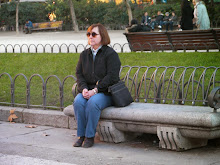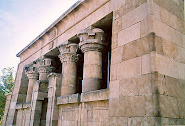 One of my favorite parts of Goddesschess is dondelion's collection of art and artifacts, some of which are "things that look like 'chess'."
While doing some research on the Gundestrup Cauldron (see prior post), I visited the website of the National Musem of Denmark, and came across this beautiful miniature replica of the original "Sun Chariot":
The Sun chariot; small copy
The sun chariot was discovered around 1400 BC when the bogs near Trundholm on Zealand went under the plow in 1902. The small six wheeled chariot was broken into many parts but this was not only done by the plow. The chariot must have been broken already when it was dumped in the bog during the Bronze Age. The pieces were salvageable, however, and formed a miniature sun disc on a horse drawn carriage. The sun disc is made from two bronze plates that have been fused together. One side has been covered in a thin layer of gold. The horse is delicately formed with patterns on the front end forming eyes, mane and reins. The casting has been done by a master. The whole piece is put together on a frame and is to be seen as a horse drawn sun on a six wheeled chariot. This miniature copy is approx. 20 cm long which makes it some what smaller that the original. It is made from bronze patinated metal with a gilded sun disc. The original is displayed at the Danish National Museum.
One of my favorite parts of Goddesschess is dondelion's collection of art and artifacts, some of which are "things that look like 'chess'."
While doing some research on the Gundestrup Cauldron (see prior post), I visited the website of the National Musem of Denmark, and came across this beautiful miniature replica of the original "Sun Chariot":
The Sun chariot; small copy
The sun chariot was discovered around 1400 BC when the bogs near Trundholm on Zealand went under the plow in 1902. The small six wheeled chariot was broken into many parts but this was not only done by the plow. The chariot must have been broken already when it was dumped in the bog during the Bronze Age. The pieces were salvageable, however, and formed a miniature sun disc on a horse drawn carriage. The sun disc is made from two bronze plates that have been fused together. One side has been covered in a thin layer of gold. The horse is delicately formed with patterns on the front end forming eyes, mane and reins. The casting has been done by a master. The whole piece is put together on a frame and is to be seen as a horse drawn sun on a six wheeled chariot. This miniature copy is approx. 20 cm long which makes it some what smaller that the original. It is made from bronze patinated metal with a gilded sun disc. The original is displayed at the Danish National Museum.
*************************************
I find this piece incredibly beautiful, and I have a hard time wrapping my head around the thought that someone just tossed it into a bog around 1400 BCE because it was broken! This does not jibe with the Museum's theory that this was a sacred piece used by priests to demonstrate the journey of the Sun across the sky (and through the Underworld) each day. Who would dare just toss a sacred artifact into a bog, even if it was broken? Only a barbarian!
Notice that the wheels have four spokes. I'm certainly no expert, but we know that the eight-spoked wheel first came into use around Armenia (far eastern Anatolia) around 1850-1800 BCE and by about 1650 BCE it was in use throughout the Middle East. Prior to the invention of the eight-spoked wheel, I believe the four-spoked wheel was the norm. So, guessing - it would seem that based on the design of the Sun Chariot's wheels, it dates back to BEFORE the eight-spoked wheel became the norm - in other words, prior to about 1650 BCE. This would make it older than the c. 1400 BCE date attributed to it.
Yes - I do not know how long it took for the improved technology of the eight-spoked wheel to reach such a far-away place from the Middle East as Trundholm! Did it take 400 years? Hmmmm....
Something about this piece reminds me of the Minoan culture - perhaps it is the "lines" of the casting itself, or perhaps it is the spiral designs, which speak to me of the Goddess. The museum says otherwise, attributing the spirals to a "unique" form of Danish artwork during the Bronze age that signified the journey of the sun across the sky during the day and through the underworld at night, day after day. This explanation is akin to the ancient Egyptian explanation for the sun's journey across the sky and what happened to it when "night" came.
I think the curators at the Museum are so eager to attribute this piece to the Bronze Age ancestors of the Danes that they are ignoring other parallels and iconography from other cultures that existed in the Bronze Age - and before. Did the Bronze Age "Danes" have the technology/metalurgical skills necessary to produce such an artifact? That is not something answered in the Museum's material on this artifact.
Here is a short video on the Sun Chariot from the Museum. Here is what the Museum says about the Sun Chariot:
The Sun Chariot – unique and sacred (scroll down to text)
There is nothing else like the Sun Chariot – at least nothing similar has appeared since it emerged from Trundholm Bog in 1902. It is the National Museum’s absolute highlight. The Sun Chariot was made in the Bronze Age, c. 1350 BC, and shows the sun on its eternal journey, drawn by a divine horse. The elegant spiral ornamentation on the golden sun disc reveals its Nordic origin. The Sun Chariot still holds an almost magical attraction. And its message is universal: it reflects existence in an eternal cycle of alternations between light and darkness.
Well, I certainly agree that the message of the Sun Chariot is universal - but I do not believe it has been definitively established that spiral decoration is Nordic in origin! Just for instance, the spirals at New Grange are much older (dating back to c. 3000 BCE) and owe nothing to the Danes. That example easily came to mind. I'm sure there are others.
Perhaps the Sun Chariot was a precious and unique artifact that was imported from the Mediterranean Area/Middle East, perhaps in exchange for precious amber.





































No comments:
Post a Comment